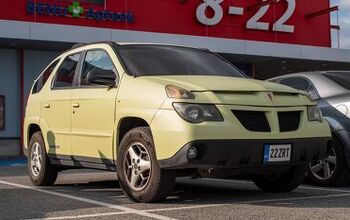Daily Podcast: CAFE Culture
The list of CAFE violators ( in PDF form) reads like a valet’s to-do list: Mercedes, Porsche, Ferrari, Maserati. These firms pay CAFE fines because, well, they can. CAFE fines are calculated by multiplying each tenth of a mile per gallon of average non-compliance by $5.50, then multiplying that dollar amount by the number of vehicles sold. As a result, luxury firms pay the highest fines when they try to go mass market: Merecedes paid about $30 million for 2007. But if CAFE is already weighted to let small companies off the hook, why are we hearing about new rules which seem to relax standards for firms selling fewer than 400k vehicles per term? Aren’t the regular loopholes enough?
The answer takes a little digging to find, but it explains everything. Proposed rules for the 2011-2015 standard ( PDF) reveal that
EPCA authorizes increasing the civil penalty up to $10.00, exclusive of inflationary adjustments, if NHTSA decides that the increase in the penalty—
(i) will result in, or substantially further, substantial energy
Doubling the CAFE fine would force the small firms to finally get serious about efficiency . . . unless there were a loophole. Hence the loophole.
Of course, that’s not going to be enough come the day when greenhouse gasses become a regulated pollutant under the Clean Air Act. As proposed rules for CAFE/GHG coordination explain:
failure to meet the standards after credit opportunities are exhausted would ultimately result in the potential for penalties under [Energy Policy and Conservation Act] (CAFE), and under the [Clean Air Act] as well. The CAA allows considerable discretion in assessment of penalties. Penalties under the CAA are typically determined on a vehicle-specific basis by determining the number of a manufacturer’s highest emitting vehicles that caused the fleet average standard violation. This is the same mechanism used for EPA’s National LEV and Tier 2 corporate average standards, and to date there have been no instances of noncompliance.
In short, fines are going to double, and the risk of a Clean Air Act violation lawsuit means non-compliant firms face double jeopardy.
More by Edward Niedermeyer
Latest Car Reviews
Read moreLatest Product Reviews
Read moreRecent Comments
- Kjhkjlhkjhkljh kljhjkhjklhkjh I'd rather they have the old sweep gauges, the hhuuggee left to right speedometer from the 40's and 50's where the needle went from lefty to right like in my 1969 Nova
- Buickman I like it!
- JMII Hyundai Santa Cruz, which doesn't do "truck" things as well as the Maverick does.How so? I see this repeated often with no reference to exactly what it does better.As a Santa Cruz owner the only things the Mav does better is price on lower trims and fuel economy with the hybrid. The Mav's bed is a bit bigger but only when the SC has the roll-top bed cover, without this they are the same size. The Mav has an off road package and a towing package the SC lacks but these are just some parts differences. And even with the tow package the Hyundai is rated to tow 1,000lbs more then the Ford. The SC now has XRT trim that beefs up the looks if your into the off-roader vibe. As both vehicles are soft-roaders neither are rock crawling just because of some extra bits Ford tacked on.I'm still loving my SC (at 9k in mileage). I don't see any advantages to the Ford when you are looking at the medium to top end trims of both vehicles. If you want to save money and gas then the Ford becomes the right choice. You will get a cheaper interior but many are fine with this, especially if don't like the all touch controls on the SC. However this has been changed in the '25 models in which buttons and knobs have returned.
- Analoggrotto I'd feel proper silly staring at an LCD pretending to be real gauges.
- Gray gm should hang their wimpy logo on a strip mall next to Saul Goodman's office.


































Comments
Join the conversation
Like we've said before, this an exceptionally complex way of getting the same thing you can get out of a simple gas tax.
Correct, dean, and under this law the bureaucracy has the "discretion" to be judge, jury and executioner.